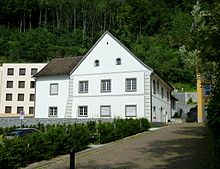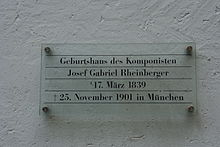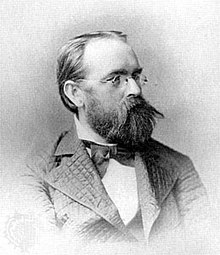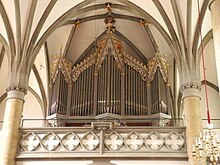Josef Gabriel Rheinberger
Josef Gabriel Rheinberger (born March 17, 1839 in Vaduz , baptized Gabriel Joseph , † November 25, 1901 in Munich ) was a composer , organist and music teacher born in Liechtenstein . At the age of twelve he came to Munich for musical training and worked there all his life, so that he is often perceived and referred to as a German composer. He was the uncle of the Liechtenstein artist Egon Rheinberger .
biography

Josef Gabriel Rheinberger, born in Vaduz in 1839, showed unusual musicality at an early age. Already at the age of seven he was organist in his hometown. In 1849 he came to the Feldkirch organist Philipp M. Schmutzer for musical training. He then went to Munich at the age of twelve and attended the Munich Conservatory directed by Franz Hauser until 1854 . He was instructed in organ playing by Johann Georg Herzog and counterpoint (composition theory) by Julius Joseph Maier . In his private life he trained with the court conductor Franz Lachner . He soon surpassed his fellow students and created numerous early works.
In 1854 Rheinberger became vice organist at the parish church of St. Ludwig and in 1857 court organist at the Theatinerkirche (St. Kajetan). From 1859 he also gave piano lessons at the conservatory. In 1863 he became court organist at the Hofkirche St. Michael .
In 1867 Rheinberger was appointed professor for organ and composition at the newly founded music school. He held this office until shortly before the end of his life. In the same year he married the poet Franziska von Hoffnaaß ("Fanny"), who wrote texts for some of his vocal works (including the cantata Der Stern von Bethlehem and the oratorio Christoforus ). In 1867 he also moved into the apartment at Fürstenstrasse 6 in Munich, where he lived until his death.
Rheinberger was one of the successful composers of his time. Publishers, musicians and choirs approached him with commissioned compositions. In 1877 he became Franz Wüllner's successor as court conductor of the Bavarian King Ludwig II. He thus assumed a central position in Catholic church music in Germany. He composed Latin masses and motets, which were pioneering in their independence from the restrictive regulations of the Cecilian church music reformers of his time: “... not a single one of the 160 works of sacred vocal music was found worthy by the German Cecilians and included in the catalog of church works approved by the Cecilians As a composition teacher at the Munich Music School and the Academy of Music in 1893, Rheinberger was an international class. Numerous awards reflect his success, including the Knight's Cross of the Papal Order of Gregory (1879), the Commander's Cross of the Bavarian Order of the Crown (1895, associated with the personal nobility) and an honorary doctorate from the University of Munich (1899).
tomb
Josef Rheinberger was buried in the old southern cemetery in Munich (Neue Arkaden, place 101 near grave field 42, location ). In 1949 the grave, damaged in World War II, was moved to the cemetery of the parish of St. Florin in his home town of Vaduz. The remains of Rheinberger and his wife have been resting there in an honorary grave since 1989 . A tombstone in the Old Southern Cemetery in Munich commemorates Josef and Franziska Rheinberger.
Meaning and reception
Work and influence
As an important representative of a diverse musical culture, Rheinberger is at the end of the classical-romantic era. His extensive oeuvre , including 197 works published with opus numbers alone , includes piano music, organ music, sacred and secular choral music, solo songs, chamber music, symphonies, concert overtures, drama music and operas.
It was mainly his organ music that made Rheinberger famous, although it only makes up a quarter of his oeuvre. In particular, the 20 organ sonatas , all set in different keys, play a large part in this. From 1875 onwards, Rheinberger composed a sonata almost every year. They were rather not intended for performance in the church, but primarily intended for the concert hall. His work was formative for the development of this genre:
“Rheinberger's importance for this genre cannot easily be overestimated. Of the composers who ever dealt with the organ sonata, he was the most important after Mendelssohn. "
Not least as a teacher of composition, Rheinberger was of great importance. His students included Stevan Stojanović Mokranjac , Luise Adolpha Le Beau , Max Bruch , Sophie Menter , Hans Koessler , Engelbert Humperdinck , Ermanno Wolf-Ferrari , Joseph Renner jun. , Richard Strauss , Lothar Windsperger , Wilhelm Furtwängler and Aloys Fleischmann as well as a whole generation of young American composers (e.g. Horatio Parker and George Chadwick ).
At the beginning of the 1870s, Rheinberger was asked by the then Prince of Liechtenstein to look for a good organ builder for the newly built St. Florin Cathedral. Rheinberger then arranged an organ, which was built by the Steinmeyer company he wrote to , and played it at the inauguration. In the 2010s, after several modifications were made, the Eule company restored it to its original condition as far as possible and named it after the composer.
Performance history
While Rheinberger was performed by well-known pianists at the end of the 19th century and was immediately successful during his lifetime, it was largely forgotten after the First World War and was hardly performed in German concert halls until 1980. As a presumed reason for this, the fact was given as early as 1939 that as a determined classicist who saw Bach and Beethoven in particular as his models, he created excellent compositions, but in music history only composers who created something "new" in one area , are remembered. Other causes may be, on the one hand, the insignificance of the genres of dramatic music, songs, secular choral music, piano and orchestral music in performance practice, on the other hand, the condemnation of his sacred composition on the part of the Cäcilians - especially the cathedral music director Ignaz Mitterer in Regensburg - who for a simple A- cappella style in the tradition of Palestrina .
Even if Rheinberger was performed more and more often in the cathedrals in Würzburg and Regensburg after the Second World War, these were mostly the same compositions. It was not until the 1980s that this repertoire was expanded and greater importance was also assigned to it nationwide in the entire German-speaking region. This went hand in hand with a general “rediscovery” of smaller composers from earlier centuries towards the end of the 20th century, with the effect on Rheinberger being extraordinarily strong.
Honors
In 1895 he was ennobled (Josef Gabriel Ritter von Rheinberger). In 1909, a memorial plaque was attached to Rheinberger's house in Munich. As a souvenir of his work, a Rheinberger monument with a plaque was erected in front of the house where he was born in Vaduz in 1940 . This has also been the headquarters of the Liechtenstein Music School since 1968.
The municipality of Vaduz has been awarding the Josef Gabriel von Rheinberger Prize every two years since 1976 .
The International Josef Gabriel Rheinberger Society was founded in 2003 to promote and disseminate his diverse work in today's cultural life .
Works

This list only takes into account the works that Rheinberger himself provided with opus numbers.
- Sacred vocal works
- Cantatas , including the Christmas cantata Der Stern von Bethlehem op.164
- 14 fairs
- 3 Requiem scoring
- 2 Stabat mater
-
Motets , hymns, songs
- u. a. Evening song (op. 69, No. 3) according to Luke 24:29 ("Stay with us, because it will be evening")
- Dramatic music
- Opera The Seven Ravens op.20
- Opera Türmers daughter op. 70
- 3 singing games
- 2 drama music
- Secular choral music
- Choral ballads
- Singing ensembles with and without accompaniment
- mixed choirs
- u. a. Forest flowers (op. 124) - Eight songs based on texts by Franz Alfred Muth
- Women's choirs
- Male choirs
- 12 songs for voice and piano
- Orchestral music
- 2 symphonies
- 3 overtures
- 4 solo concerts (including 1 piano concerto, 2 organ concerts in F major op.137 and G minor op.177)
- Chamber music
- String quartets, string quintets
- Piano trios, sonatas for solo instruments and piano
- u. a. Sonata for clarinet and piano op. 105 a
- 4 piano sonatas
- Organ works
- 2 organ concerts
- 20 organ sonatas
- 12 Fughetten op.123a, 12 Fughetten op.123b
- 12 monologues op.162
- 12 meditations op.167
- Preludes, trios, character pieces,
- Works for violin or oboe and organ
literature
- Harald Wanger: Rheinberger, Josef Gabriel. In: Historical Lexicon of the Principality of Liechtenstein .
- Karl Dienst : Rheinberger, Joseph Gabriel. In: Biographisch-Bibliographisches Kirchenlexikon (BBKL). Volume 8, Bautz, Herzberg 1994, ISBN 3-88309-053-0 , Sp. 134-136.
- Stephan Hörner : Rheinberger, Josef Gabriel von. In: New German Biography (NDB). Volume 21, Duncker & Humblot, Berlin 2003, ISBN 3-428-11202-4 , p. 489 f. ( Digitized version ).
- Hans-Josef Irmen : Thematic directory of the musical works of Gabriel Josef Rheinberger. (Studies on the history of music in the 19th century; Vol. 37). Research company of the Fritz Thyssen Foundation. Musicology working group. Regensburg 1974.
- Hans-Josef Irmen: Gabriel Joseph Rheinberger as the antipode of Cäcilianism . (Studies on the history of music in the 19th century; Vol. 22). Research company of the Fritz Thyssen Foundation. Musicology working group. Regensburg 1970.
- Hans-Josef Irmen, Harald Wanger: Gabriel Joseph Rheinberger. Letters and documents . 9 volumes. Vaduz 1982–1988.
- Birger Petersen-Mikkelsen, Martin West (Eds.): Gabriel Josef Rheinberger and his time: The presentations of the symposium on the occasion of the 15th International Organ Weeks Eutin 2001 . Books on Demand , 2002, ISBN 978-3-8311-3873-9 .
- Harald Wanger: Josef Gabriel Rheinberger. Life and work in pictures. Carus Verlag, Stuttgart 1998, ISBN 978-3-923053-56-8 .
- Martin Weyer : Josef Rheinberger's organ works. Florian Noetzel Verlag, Wilhelmshaven 1994. ISBN 3-7959-0665-2 .
Web links
- Works by and about Josef Gabriel Rheinberger in the catalog of the German National Library
- Works by and about Josef Gabriel Rheinberger in the German Digital Library
- International Josef Gabriel Rheinberger Society Liechtenstein
- Sheet music and audio files by Josef Rheinberger in the International Music Score Library Project
- Sheet music in the public domain by Josef Gabriel Rheinberger in the Choral Public Domain Library - ChoralWiki (English)
- Rheinberger Complete Edition
- Catalog of works by Carus-Verlag
- Catalog of works at Klassika
- Song portal
- Rheinberger's music autograph
Individual evidence
- ↑ Hans-Josef Irmen: Gabriel Josef Rheinberger as the antipode of Cäcilianism . Gustav Bosse Verlag, Regensburg 1970, p. 206 .
- ^ Martin Weyer: The organ works of Josef Rheinberger . Ed .: Florian Noetzel Verlag. Wilhelmshaven 1994, p. 11 .
- ^ Martin Weyer: The German organ sonata from Mendelssohn to Reger . Regensburg 1969, p. 135 .
- ↑ HERMANN EULE ORGELBAU - Vaduz, St. Florin's Cathedral. Retrieved July 11, 2020 .
- ^ Hanns Steger: Josef Rheinberger's view of music . Ed .: Georg Olms Verlag. Hildesheim 2001, p. 235-239 .
- ^ Ludwig Lade: "Josef Rheinberger" . In: magazine for music . No. 106 , 1939, pp. 295-297 .
- ^ Hanns Steger: Josef Rheinberger's view of music . Ed .: Georg Olms Verlag. Hildesheim 2001, p. 42-44 .
- ^ Hanns Steger: Josef Rheinberger's view of music . Ed .: Georg Olms Verlag. Hildesheim 2001, p. 44-47 .
- ^ Harald Wanger: Rheinberger, Josef Gabriel. In: Historical Lexicon of the Principality of Liechtenstein . December 31, 2011 , accessed June 13, 2019 .
| personal data | |
|---|---|
| SURNAME | Rheinberger, Josef Gabriel |
| ALTERNATIVE NAMES | Rheinberger, Joseph Gabriel von; Rheinberger, Gabriel Joseph (baptismal name) |
| BRIEF DESCRIPTION | Liechtenstein composer |
| DATE OF BIRTH | March 17, 1839 |
| PLACE OF BIRTH | Vaduz |
| DATE OF DEATH | November 25, 1901 |
| Place of death | Munich |





